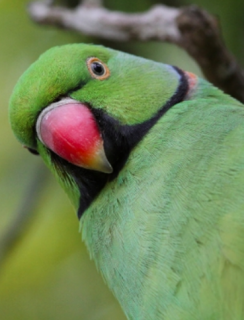Echo Parakeet |
|
|
Also known as: Mauritius Parakeet
Did You Know?
The Echo Parakeet differs from most Asian and African parakeets by being bright emerald green rather than olive green.Programs & Projects
WPT has worked with numerous partners to help save this species. Learn moreAcademic Research
Related publications: Alexandrinus equesSpecies Profile
Genus: Alexandrinus | Species: eques
Size:
42cm (16.4 in)
Weight:
167-193g (5.8-6.7 oz)
Subspecies including nominate:
one
Colour Adult:
Male-color generally emerald to grass green, with yellowish underparts and underwings. Black thin line from cere to eyes, broad moustache-like stripes on lower cheeks and chin out to sides of neck, and narrow black neck-stripes bordered by blue patches over ears and neck and below by pink lines going to hindneck. Upper beak red, lower black. Eye pale yellow. Female-plainer with all black beak, no head markings; shorter tail.
Colour Juvenile:
As in adult female, but tail short; bill coral/pink in very young individuals.
Call:
Low call cha-chaachaa at a rate of two notes/second interspersed with harsher notes. High pitched call when excited or in flight. Bark in alarm. Also melodious purring or whistling.
Listen NowMore Information:
Content Sources:
CITES
BirdLife International
A Guide to Parrots of the World, Juniper and Parr, 1998
Cornell Lab of Ornithology/Birds of the World
ML Media Collection Catalogue 167696 Echo Parakeet Psittacula echo, Erickson, Jon, Mauritius, June 4 2010, Cornell Lab of Ornithology Site
Parrots of the World, Forshaw and Cooper, 1989.
Vanished and Vanishing Parrots, Forshaw, 2017.
Parrots of the World, Forshaw, 2006.
Mauritian Wildlife Foundation
V. Tatayah in litt. 2012.
Carl Jones in litt. 2005.
Did You Know?
The Echo Parakeet differs from most Asian and African parakeets by being bright emerald green rather than olive green.Programs & Projects
WPT has worked with numerous partners to help save this species. Learn moreAcademic Research
Related publications: Alexandrinus equesSpecies Care
Captive Status:
Some captive breeding (hand-rearing) for re-introduction in the wild; otherwise not raised in captivity.
Longevity:
Not recorded.
Housing:
Gerald Durrell Endangered Wildlife Sanctuary (GDEWS).
Diet:
Birds at Plaine Lievre (field station used by Mauritian Wildlife Foundation in Black River Gorges Nat'l Park) are supplemented with pelleted food.
Enrichment:
Provided with local foods and browse.
Nest Box Size:
Next hollows at least 50cm (19.5 in) deep and 20cm (7.8 in) wide.
Clutch Size:
1-4 eggs
Incubation Time:
21-25 days
Fledging Age:
8-9 weeks
Hatch Weight:
8.5g (0.2 oz)
Peak Weight:
150g (5.25 oz)
Weaning Weight:
130-160g (4.55-5.6 oz)
Did You Know?
The Echo Parakeet differs from most Asian and African parakeets by being bright emerald green rather than olive green.Programs & Projects
WPT has worked with numerous partners to help save this species. Learn moreAcademic Research
Related publications: Alexandrinus equesSpecies Wild Status
World Population:
Over 750 (2017)
IUCN Red List Status:
Vulnerable
CITES Listing:
Appendix I
Threat Summary:
A BirdLife 'restricted-range' species. Is affected by severe deforestation and degradation of habitat, as well as the effects on vegetation of introduced pigs Sus scrofa and rusa deer Rusa timorensis. Crab-eating macaques Macaca fascicularis, black rats Rattus rattus and numerous species of aggressive insects pose a threat to parakeets by raiding nests and competing for native fruits. The loss of old native trees to storm damage and age has intensified competition for nest cavities.
Range:
Found on Mauritius, formerly on Reunion.
Habitat:
Upland forest, lower-level scrub forest.
Wild Diet:
Fruit of native plants such as Calophyllum, Tabernaemontana, Labourdonnaisia, Mimusops, Syzygium, Sideroxylon, Nuxia, Diospyros, Eugenia and Erythrospermum. Also buds, young shoots, leaves, flowers, seeds, twigs, sap and bark.
Ecology and Behaviour:
Thought to favour communal roosting. Relies solely on native foods. Generally solitary or in pairs during breeding season.
Clutch and Egg Size:
2-3 eggs, 33.0 x 26.0mm (1.3 x 1 in).
Breeding Season:
September-February; nests in rain-sheltered cavity at least 10m up in the hollow limb of an old, usually living tree.
Related Links:
Did You Know?
The Echo Parakeet differs from most Asian and African parakeets by being bright emerald green rather than olive green.Programs & Projects
WPT has worked with numerous partners to help save this species. Learn moreAcademic Research
Related publications: Alexandrinus equesMembers Only Resources
Please log-in now to find more research, resources and tools.
Not a Member?
Find more great information:
Gain exclusive access to 600+ pages of additional research, seminars and podcasts, specialists to ask your toughest questions, and dozens of other fun resources - when you become a WPT member.
Join Today >>

































